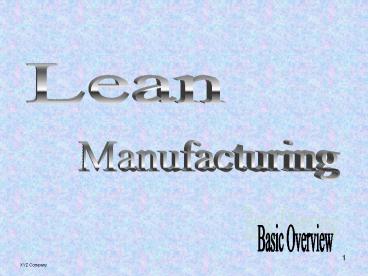Lean Manufacturing - PowerPoint PPT Presentation
1 / 20
Title:
Lean Manufacturing
Description:
Lean Manufacturing Defined A systematic approach to identifying and eliminating waste (non-value-added activities) through continuous improvement by flowing the ... – PowerPoint PPT presentation
Number of Views:348
Avg rating:3.0/5.0
Title: Lean Manufacturing
1
Lean
Manufacturing
Basic Overview
2
Lean Manufacturing
- Is a way of life. It is a never ending
process - Its tools need to tailored to meet XYZ Companys
needs. - Not a one size fits all method.
3
Lean Manufacturing Defined
- A systematic approach to identifying and
eliminating waste (non-value-added activities)
through continuous improvement by flowing the
product at the pull of the customer in pursuit of
perfection - --The MEP Lean Network
WASTE
WASTE
XYZ Company
CUSTOMER
SUPPLIER
WASTE
WASTE
4
Lean Manufacturing Objectives
XYZ Company
OUR CUSTOMER
Strealthy growth
Satisfaction
ASSEMBLY PROCESS
Elimination of muda or waste
5
The Principles of Lean Manufacturing
- Focus on Value - Your customer determines value.
- Eliminate Waste - Eliminate all forms of waste.
- Build only what customer Pulls
- Quality, Quality, Quality
.Jim Womack
6
What is Waste?
- Anything that adds Cost
- to the product
- without adding Value
Value ?
Ask yourself IS MY CUSTOMER PAYING FOR THIS ?
Yes Can I do it faster, better, safer ?
No Why am I doing it ?!
7
Cost Profit Relationship
COSTS INCREASES
V
V
V
PROFIT DECREASES
8
The Never Ending Cycle..
Value !!
Low Cost High Quality Availability
XYZ Company
OUR CUSTOMER
9
How can we make/increase PROFITS ?
Selling Price
Increase our selling price
P
Selling Price
P
XYZ Companys Cost
P
Decrease our cost
XYZ Companys Cost
Decrease our cost !!! - HOW ?
10
7 Forms of Waste
Value - Add
Value - Add
LEAN ELIMINATING THE WASTES
11
7 Forms of Waste
- Overproduction Producing faster than
consumption - Defects Variations and complexity
- Non-value added processing Lack of standard
methods - Waiting Producing slower than consumption
- Transportation Disconnected operations
- Excess motion Lack of better processes
- Excess inventory Long lead times, ..
12
Bricklaying, through late Nineteenth Century
- The brick weighs about five pounds (2.3 kg). How
much is the worker actually raising and lowering
every time he bends over for another brick?
Source Levinson Productivity Systems,
P.C. http//www.ct-yankee.com/lean/usa.ppt
13
Bricklaying, after Frank Gilbreth
- The joke about the underachievers and the light
bulb isn't so funny any more. - Lesson waste can, by long habit ("living with
it," "working around it") become built into a job.
Source Levinson Productivity Systems,
P.C. http//www.ct-yankee.com/lean/usa.ppt
14
INVENTORY Ship Analogy
GOOD OR BAD ?
Inventory Level
Finished Goods
Raw Material
Long Lead Time
Poor Quality
Poor Training
Poor Housekeeping
Downtime
Poor Layout
No Standards
Scrap
Long Setups
Poor Communication
Poor Scheduling
Supplier Relations
15
INVENTORY Ship Analogy
Cannot reduce inventory instantaneously!
Finished Goods
Raw Material
Inventory Level
Long Lead Time
Poor Quality
Poor Training
Poor Housekeeping
Downtime
Poor Layout
No Standards
Scrap
Long Setups
Poor Communication
Poor Scheduling
Supplier Relations
16
INVENTORY Ship Analogy
Solve problems Remove rocks before lowering
inventory!
Finished Goods
Raw Material
Inventory Level
Poor Housekeeping
Downtime
Poor Layout
No Standards
Scrap
Long Setups
Poor Communication
Poor Scheduling
Supplier Relations
17
Identify waste in your cell
- Re-pack
- Scrap
- Load/Unload
- Containment
- Expedite
- Counting
- Sorting
- Storing
- Invoices
- Rework
18
Lean Manufacturing Tools
- Value stream mapping
- Quality at the source
- Workplace organization 5S
- TPM
- Visual Management
- Set-up reduction (SMED)
- Batch size reduction (one-piece-flow)
- Cellular manufacturing
- Standardized work (CYCLE Time)
- Work balancing (TAKT Time)
- Production leveling / smoothing / Heijunka
- Point-of-use systems
- Kanban
- Kaizen
19
Lean Building Blocks
Continuous Improvement
Pull/Kanban
Quick Changeover
Quality at Source
Cellular/Flow
Batch Reduction
Plant Layout
TPM
Standardized Work
5S System
Visual Systems
POUS
Value Stream Mapping
Teams/Employee Involvement
Source The MEP Lean Network
20
Toyota Production System
Best Quality - Lowest Cost - Shortest Lead
TimeThrough Eliminating Waste
Just in TimeThe right partat the right timein
the right amount
JidokaBuilt in Quality
- Manual / Automatic Line Stop
- Labor-Machine Efficiency
- Error Proofing
- Visual Control
- Continuous Flow
- Pull System
- Level Production (Heijunka)
Flexible, Capable,Highly Motivated People
Operational Stability
Standardized Work Total Productive Maintenance
Robust Products Processes Supplier Involvement































